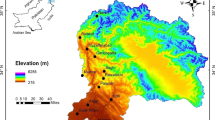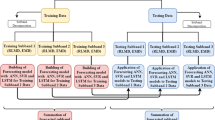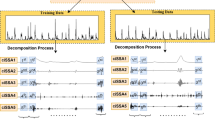Abstract
Annual streamflow prediction is of great significance to the sustainable utilization of water resources, and predicting it accurately is challenging due to changes in streamflow have strong nonlinearity and uncertainty. To improve the prediction accuracy of annual streamflow, this study proposes a new hybrid prediction model based on extracting information from high-frequency components of streamflow. In the proposed model, the original streamflow data is decomposed by ensemble empirical mode decomposition (EEMD) into several intrinsic mode functions (IMFs) with different frequencies. Then, the dominant component and residual component are identified from the high-frequency components IMF1 and IMF2 using singular spectrum analysis (SSA), and the residual components are accumulated as a new component. Finally, all the components, including the new component that is not noise, are modelled by support vector machine (SVM), and the SVM is optimized by grey wolf optimizer (GWO). To analyse and verify the proposed model, the annual streamflow data are collected from the Liyuan River and Taolai River in the Heihe River Basin, and six models, autoregressive integrated moving average (ARIMA), cross validation (CV)-SVM, GWO-SVM, EEMD-ARIMA, EEMD-GWO-SVM and modified EEMD-GWO-SVM are considered as comparison models. The results indicate that the prediction performance of the proposed model is obviously better than that of other reference models, and extracting valuable information from high-frequency components can effectively improve annual streamflow prediction. Thus, the high-frequency components contained in the original streamflow series have an important impact on obtaining accurate streamflow prediction, and the proposed model makes full use of the high-frequency components and provides a reliable method for streamflow prediction.















Similar content being viewed by others
Availability of Data and Materials
The data used in this study are available from the corresponding author on request.
Abbreviations
- EEMD:
-
Ensemble empirical mode decomposition
- IMF:
-
Intrinsic mode functions
- SSA:
-
Singular spectrum analysis
- SVM:
-
Support vector machine
- GWO:
-
Grey wolf optimizer
- ARIMA:
-
Autoregressive integrated moving average
- CV:
-
Cross validation
- ANN:
-
Artificial neural network
- VC:
-
Vapnik-Chervonenkis
- RF:
-
Random forest
- EMD:
-
Empirical mode decomposition
- VMD:
-
Variational mode decomposition
- GBRT:
-
Gradient boosting regression
- PSO:
-
Particle swarm optimization
- DE:
-
Differential evolution
- ABC:
-
Artificial bee colony
- RA:
-
Residual-component accumulation
- SVD:
-
Singular value decomposition
- RBF:
-
Radial basis function
- PACF:
-
Partial autocorrelation function
- MAE:
-
Mean absolute error
- RMSE:
-
Root mean square error
- MAPE:
-
Mean absolute percentage error
- R:
-
Coefficient of correlation
- NSEC:
-
Nash-Sutcliffe efficiency coefficient
References
Abdollahi S, Raeisi J, Khalilianpour M, Ahmadi F, Kisi O (2017) Daily mean streamflow prediction in perennial and non-perennial rivers using four data driven techniques. Water Resour Manag 31:4855–4874
Bai Y, Bezak N, Sapac K, Klun M, Zhang J (2019) Short-term streamflow forecasting using the feature-enhanced regression model. Water Resour Manag 33(14):4783–4797
Bian XQ, Zhang L, Du ZM, Chen J, Zhang JY (2018) Prediction of sulfur solubility in supercritical sour gases using grey wolf optimizer-based support vector machine. J Mol Liq 261:431–438
Chu H, Wei J, Jiang Y (2021) Middle- and long-term streamflow forecasting and uncertainty analysis using lasso-DBN-boostrap model. Water Resour Manag 35:2617–2632
Chu H, Wei J, Li J, Qiao Z, Cao J (2017) Improved medium- and long-term runoff forecasting using a multimodel approach in the Yellow River headwaters region based on large-scale and local-scale climate information. Water 9(8):608
Chu H, Wei J, Qiu J (2018) Monthly streamflow forecasting using EEMD-Lasso-DBN method based on multi-scale predictors selection. Water 10(10):1486
Freire PKDMM, Santos CAG, da Silva GBL (2019) Analysis of the use of discrete wavelet transforms coupled with ANN for short-term streamflow forecasting. Appl Soft Comput 80:494–505
Hamaamin YA, Nejadhashemi AP, Zhang Z, Giri S, Woznicki SA (2016) Bayesian regression and neuro-fuzzy methods reliability assessment for estimating streamflow. Water 8(7):287
Hamad A, Houssein EH, Hassanien AE, Fahmy AA (2017) A hybrid EEG signals classification approach based on grey wolf optimizer enhanced SVMs for epileptic detection. In Proceedings of the International Conference on Advanced Intelligent Systems and Informatics. Adv Intell Syst Comput 639:108–117
Harraki W, Ouazar D, Bouziane A, Harraki IE, Hasnaoui D (2021) Streamflow predition upstream of a dam using SWAT and assessement of the impact of land use spatial resolution on model performance. Envrion Process 8:1165–1186
He X, Luo J, Li P, Zuo G, Xie J (2020) A hybrid model based on variational mode decomposition and gradient boosting regression tree for monthly runoff forecasting. Water Resour Manag 34:865–884
He X, Luo J, Zuo G, Xie J (2019) Daily runoff forecasting using a hybrid model based on variational mode decomposition and deep neural networks. Water Resour Manag 33:1571–1590
Li XL, Lue H, Horton R, An T, Yu Z (2014) Real-time flood forecast using the coupling support vector machine and data assimilation method. J Hydroinf 16(5):973
Lin GF, Chou YC, Wu MC (2013) Typhoon flood forecasting using integrated two-stage Support Vector Machine approach. J Hydrol 486:334–342
Linares-Rodriguez A, Lara-Fanego V, Pozo-Vazquez D, Tovar-Pescador J (2015) One-day-ahead streamflow forecasting using artificial neural networks and a meteorological mesoscale model. J Hydr Eng 20(9):05015001
Liu W, Guo G, Chen F, Chen Y (2019) Meteorological pattern analysis assisted daily PM2.5 grades prediction using SVM optimized by PSO algorithm. Atmos Pollut Res 10(5):1482–1491
Liu Y, Guo J, Sun H, Zhang W, Wang Y, Zhou J (2016) Multiobjective optimal algorithm for automatic calibration of daily streamflow forecasting model. Math Probl Eng 10:1–13
Mirjalili S, Mirjalili SM, Lewis A (2014) Grey wolf optimizer. Adv Eng Softw 69(3):46–61
Mohammadi B, Ahmadi F, Mehdizadeh S, Guan Y, Pham QB, Linh NTT, Tri DQ (2020) Developing novel robust models to improve the accuracy of daily streamflow modeling. Water Resour Manag 34:3387–3409
Ni L, Wang D, Wu J, Wang Y, Liu J (2020) Streamflow forecasting using extreme gradient boosting model coupled with Gaussian mixture model. J Hydrol 586:124901
Niu M, Hu Y, Sun S, Liu Y (2018) A novel hybrid decomposition-ensemble model based on VMD and HGWO for container throughput forecasting. Appl Math Modell 57:163–178
Niu WJ, Feng ZK, Chen YB, Zhang HR, Cheng CT (2020) Annual streamflow time series prediction using extreme learning machine based on gravitational search algorithm and variational mode decomposition. J Hydrol Eng 25(5):04020008
Rezaie-Balf M, Nowbandegani SF, Samadi SZ, Fallah H, Alaghmand S (2019) An ensemble decomposition-based artificial intelligence approach for daily streamflow prediction. Water 11(4):709
Rodrigues PC, Pimentel J, Messala P, Kazemi M (2020) The decomposition and forecasting of mutual investment funds using singular spectrum analysis. Entropy 22(1):83
Saunders C, Stitson MO, Weston J, Holloway R, Bottou L, Scholkopf B, Smola A (2002) Support Vector Machine Comput Sci 1(4):1–28
Sharma Y, Saikia LC (2015) Automatic generation control of a multi-area ST–Thermal power system using Grey Wolf Optimizer algorithm based classical controllers. Electr Power Energy Syst 73:853–862
Singh VP, Cui H (2015) Entropy theory for streamflow forecasting. Environ Process 2:449–460
Sudheer C, Maheswaran R, Panigrahi BK, Mathur S (2014) A hybrid SVM-PSO model for forecasting monthly streamflow. Neural Comput Appl 24(6):1381–1389
Sun W, Zhang J (2020) Carbon price prediction based on ensemble empirical mode decomposition and extreme learning machine optimized by improved bat algorithm considering energy price factors. Energies 13:3471
Tabbussum R, Dar AQ (2021) Comparison of fuzzy inference algorithms for stream flow prediction. Neural Comput Appl 33:1643–1653
Tawhid MA, Ali AF (2017) A Hybrid grey wolf optimizer and genetic algorithm for minimizing potential energy function. Memet Comput 9(9):1–13
Valizadeh N, Mirzaei M, Allawi MF, Afan HA, Mohd NS, Hussain A, El-Shafie A (2018) Artificial intelligence and geo-statistical models for stream-flow forecasting in ungauged stations: state of the art. Nat Hazards 86(3):1377–1392
Wang L, Li X, Ma C, Bai Y (2019) Improving the prediction accuracy of monthly streamflow using a data-driven model based on a double-processing strategy. J Hydrol 573:733–745
Wang WC, Chau KW, Qiu L, Chen YB (2015) Improving forecasting accuracy of medium and long-term runoff using artificial neural network based on EEMD decomposition. Environ Res 139:46–54
Wang Z, Qiu J, Li F (2018) Hybrid models combining EMD/EEMD and ARIMA for long-term streamflow forecasting. Water 10(7):853
Wu Z, Huang NE (2009) Ensemble empirical mode decomposition: a noise-assisted data analysis method. Adv Adapt Data Anal 1:1–41
Yaseen ZM, Ebtehaj I, Bonakdari H, Deo R, Mehr D, Mohtar WHMW, Diop L, El-shafie A, Singh VP (2017) Novel approach for streamflow forecasting using a hybrid ANFIS-FFA model. J Hydrol 2017:263–276
Yaseen ZM, Mohtar WHMW, Ameen AMS, Ebtehaj I, Razali SFM, Bonakdari H, Salih SQ, AI-Ansari N, Shahid S (2019) Implementation of univariate paradigm for streamflow simulation using hybrid data-driven model: case study in Tropical Region. IEEE Access 7:74471–74481
Yu PS, Yang TC, Chen SY, Kuo CM, Tseng HW (2017) Comparison of random forests and support vector machine for real-time radar-derived rainfall forecasting. J Hydrol 552:92–104
Zendehboudi A, Baseer MA, Saidur R (2018) Application of support vector machine models for forecasting solar and wind energy resources: A review. J Cleaner Prod 199:272–285
Zubaidi SL, Dooley J, Alkhaddar RM, Abdellatif M, Al-Bugharbee H, Ortega-Martorell S (2018) A Novel approach for predicting monthly water demand by combining singular spectrum analysis with neural networks. J Hydrol 561:136–145
Funding
This work was supported by the Scientific Research Program of the Higher Education Institutions of Gansu Province (2020A-016), and the Foundation of Northwest Normal University of China (NWNU-LKQN2019-18, NWNU-LKQN2020-21).
Author information
Authors and Affiliations
Contributions
Lili Wang: Conceptualization, Methodology, Software, Writing – original draft, review and editing. Yanlong Guo: Formal analysis, Visualization, Writing – review and editing. Manhong Fan: Investigation, Validation, Writing – review and editing.
Corresponding author
Ethics declarations
Ethics Approval
Not applicable.
Consent to Participate
Not applicable.
Consent to Publish
Not applicable.
Competing Interests
The authors declare that they have no conflicts of interest to this work.
Additional information
Publisher's Note
Springer Nature remains neutral with regard to jurisdictional claims in published maps and institutional affiliations.
Rights and permissions
About this article
Cite this article
Wang, L., Guo, Y. & Fan, M. Improving Annual Streamflow Prediction by Extracting Information from High-frequency Components of Streamflow. Water Resour Manage 36, 4535–4555 (2022). https://doi.org/10.1007/s11269-022-03262-6
Received:
Accepted:
Published:
Issue Date:
DOI: https://doi.org/10.1007/s11269-022-03262-6




